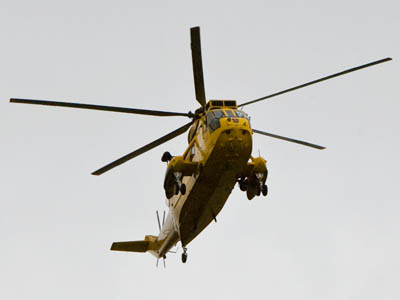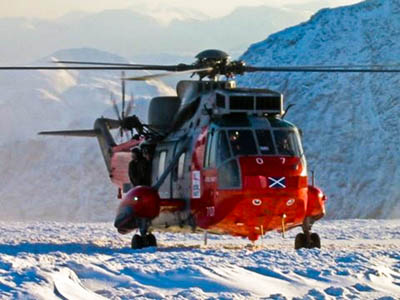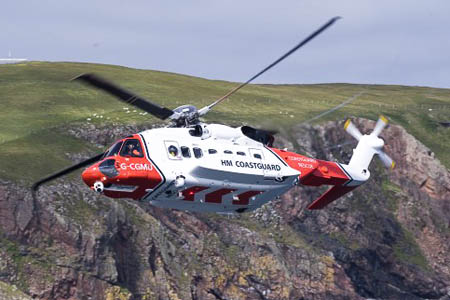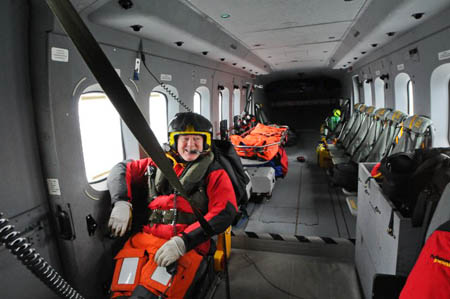
An RAF Sea King: the craft will be withdrawn from 2012
The familiar yellow ‘paraffin budgies’ that have plucked thousands of stricken climbers and walkers from Britain’s mountains are set to disappear under a plan to privatise the country’s search and rescue helicopters.
A fleet of black and orange 167mph aircraft will replace the Sea Kings operated by the Royal Air Force and Royal Navy. The new helicopters, to be introduced from 2012, will be run by a private consortium that includes the Royal Bank of Scotland, but with some Ministry of Defence crews.

The Royal Navy's Sea Kings will no longer operate from HMS Gannet. Photo: Royal Navy
The Government today announced that the Soteria Consortium had won the bid to run the harmonised search and rescue helicopter service in a contract worth £6bn over 25 years. The group includes, in addition to the bank, French company Thales, Canadian Helicopter Corporation and Sikorsky. It will use Sikorsky S92A craft, similar to ones used by the Coastguard in Scotland.
These helicopters are bigger and faster than the ageing Sea Kings currently used by the RAF and Royal Navy, and can carry 10 passengers seated in crashworthy seating with one stretcher or six seated and two on stretchers in the search and rescue role. The helicopter has twin, high-speed winches which the Government says increases the efficiency and safety of rescuing people in danger; both winches are identical and rescue is possible using either.
The new service, with headquarters at Abbey Wood, Bristol, will be jointly managed by the Ministry of Defence and the Maritime and Coastguard Agency. It is understood military search and rescue helicopter crews will be reduced from 240 to 66, with civilian staff ‘trained to the same high standards’, according to the Ministry of Defence.

The Sikorsky S92A helicopters will be similar to those operated at present by the MCA at Stornoway and Sumburgh
The four Coastguard search and rescue stations will be the first to come under the new regime, with the eight MoD bases following. It is likely HMS Gannet at Prestwick airport, from where the grey and red Royal Navy Sea Kings operate, will close, with operations transferred to Glasgow airport.
The contract for the new search and rescue helicopter service, one of the Government’s biggest ever privatisations, will be finalised later this year. At present, civilian rescues are carried out by the RAF, Royal Navy and Coastguard. Prince William is currently training to be an RAF search and rescue helicopter pilot.
MoD minister Quentin Davies said: “The new service, which will begin with a phased introduction which is anticipated to begin in 2012, will bring together the current search and rescue helicopter provision into one highly effective and harmonised service under a single contract providing the British taxpayer with an excellent service for many years to come.
“The future service will benefit from modern, fast, reliable helicopters and will continue to operate from 12 bases in order to ensure that it provides a fully effective SAR service.”
Paul Clark, the parliamentary under-secretary of state at the Department for Transport, said: “The new harmonised service is an excellent opportunity to build upon the high regard that the UK SAR service is so rightly held. The Maritime and Coastguard Agency manage a SAR service from their four bases that has already been successfully delivered by a contractor for over 20 years and the new service will build on this proven track record.”

The cabin of a Coastguard Sikorsky S92A
The Sikorsky S92A is used in the oil and gas industry and the Maritime and Coastguard Agency on Shetland and the Isle of Lewis in northern Scotland. The helicopter has a cruising speed of 145 knots (167mph, 269kph), with a radius of operation of more than 260 nautical miles (299 miles, 482km).
The aircraft is about 30 per cent faster and has approximately 70 nautical miles greater radius of operation than the Sea King. The cabin is more than 1.7m (5½ft) high, has a large door on its starboard side and a ramp at the rear which the MoD says will allow easy access for casualties and hospital care equipment such as incubators.
The SAR-H S92A has a purpose-built paramedic station including piped mains oxygen and an electrical power circuit within the cabin that allows immediate life-saving care to be administered.
The MoD says the fleet will be able to attend low-level overland night-time incidents which require pilots to use night-vision goggles. All helicopters will have forward looking infra-red equipment which enables the crew to search the terrain, over sea or land, in low light conditions.
Although the RAF and RN Sea Kings and their crews are primarily a military provision, about 90 per cent of their work is carried out supporting civilian operations such as the country’s mountain rescue teams.
The Coastguard’s four Sikorsky S92s were temporarily grounded in March last year after a safety scare. The aircraft were modified after a fatal crash involving an S92 in Newfoundland.
The Wok Smuggler
09 February 2010Is this the thin end of the wedge? How long before we are being charged to use the helicopters? Volunteer SAR teams will not be able to fund the use of these machines so will it mean in years to come everyone will need insurance to enjoy the hills or the sea. If costs esculate as they are likely to do as who has ever herad of the MOD getting its' costings right the operator will be faced with 2 choices - curtail operations or charge. This is very bad news. Why can't the money allocatted for this be given to the armed services for them to provide the services? Why not form one service under the auspices of the armed services and keep buisness out of this?
Nervous passenger
09 February 2010Hmm. Am I just being cynical in thinking that a privatised serviced with a hefty price tag attached is just the thing you need if you are going to start charging for mountain rescue?
Peter Stuart
09 February 2010I hope they stay a float longer than RBS banks and co sponsoring them. Nothing is sacred anymore. They will be charging to walk the hills, to breathe the air and to get rescued. The whole world is just one big marketing and sales job, and one big rip off.
A serving Mountain Rescue troop
09 February 2010Guys, I think you've got it all wrong. This new aircraft is fantastic I know ive been in it! As stated in the report its a lot faster, more capable, carries a bigger load and can fly further. All this means that casualties have a better chance of staying alive on the hill and on thier way to hospital.
The comment about volunteer SAR teams not being able to afford these machines dosn't make sense. MRT 's and SRT's are all volunteers they dont pay for the use of the helicopter, its an asset they call upon to assist in a callout. The aircraft will be paid for through the defence budget or looked at another way through your taxes. Under the Chicago Convention 1944 the UK has to provide SAR in its Search and Rescue Region this applies to sinking ships as much as missing hillwalkers and is a different to how it works in the Alps.
Regardless of helicopter avalibility the MRT's and SRT's will still respond to a callout offering a free, proffessional volunteer service. This system has work for the last 60 years and is unlikely to change in the future.
rhodesy
09 February 2010What a shame. it's been in the offing for a while and I personally have been dreading it. I think you could be right about charging and the need for insurance when we go into hills - I can see this leading to deaths.
"A serving mountain rescue troop" - he isn't saying that the MRT's do foot the bill, he's merely suggesting that this may be the next step.
Nervous passenger
09 February 2010I appreciate that the rescue teams will still be free. I've yet to speak to any rescue team member who wants to be paid for turning out. What worries me is that when a chopper is called out it will come with a bill. If you think that can't happen you might also think that you would never be charged for NHS casualty treatment. But if you are injured in a road accident you already get a bill for treatment which the car's insurer is expected to pay. What's the diference between that and charging for a chopper, especially if you have insurance through, say, the BMC as many walkers ands climbers do?
With the public finances in the state they are in I can hear the Chancellor licking his lips and counting the cash already. It would be an easy sell for a politician to make to the general public, especially if Serving Troop is right and the cost is coming out of defence spending at a time when the MoD reckons it's already too skint to equip our troops properly.
moggy
09 February 2010I SAY WHAT GOING ON PRIVATE CHOPPERS BEING USED I SAY NO NO NO N NO NO NO THE RAF YELLOW CHOPPER ARE PART OF ARE HISTORY
I SAY NO
MOGGY IN LEICESTER
HeliHub.com
10 February 2010This would not have been farmed out to a private operator if it did not make financial sense - and as a taxpayer I welcome the move on this basis. We already have basic helicopter training at Shawbury and Middle Wallop run by civil operators, and also the VIP flight out of Northolt.
This SAR contract needs to be seen in context. We have had 4 out of the 12 UK SAR bases run by a commercial operator since 1987 and that that seems to have gone fine. This announcement brings the other 8 bases in line and will end with one contract covering all 12 bases for 25 years.
This move makes me wonder what other cost savings can be made for my taxpayer pound, and not just in defence. Is our Government really that inefficient that privatising makes sense? Perhaps the answer is to get rid of the Labour Government? We'll get the chance soon enough!
R Roberts
10 February 2010H'mmmmm I worked in SAR for 10yrs and HM coast Gaurd does come at a cost!
1. A skill honed in peace time now to be lost by Miliatary Crews.
I'm sure training will carry on but there's nothing like the real thing! As ground crew this was the nearest we got day to day to operational situations prior to the Balkans and the Gulf.
2. Why didn't we insist the operator had to use British equipment i.e. the Merlin? (that includes HMCG).
3. I'm not sure whether like Bristows HMCG will charge for training with MRT's and RLNI so these volunteer service will suffer if they do!
4. A big loss in terms of PR for the services
Nuff Said I could go on
Russ R
I did hear some years ago it was to be privatised as I did consider applying for a job when I left the services but like every civilianised military job I expect they'll be paying peanuts for what it a highly skilled and important and I can't subscribe to that....
Gordon
10 February 2010c'mon - surely if we can spend £50 on petrol to get to the hills and £150 for a jacket, we won't miss £1 per week for SAR? Concessions for the 3.5m unwaged apply.
Gordon
Sam
10 February 2010The new helicopters are fine but a PPP contract to run them is a waste of money.
As to the question of mountain insurance, I'm not sure how it could ever be policed properly. You could fence off all the hills but all it takes is some cutting equipment and a harsh winter to see to most of the fences.
Gordon
10 February 2010It would not be policed as you could choose to go to the hills uninsured, be rescued, invoiced, taken to court where payment would be extracted (if you have the assets to pay) or bankrupted, to escape having to pay or an attachment to earnings ordered.
As ever the need to generate profits will be at the cost of providing our own services with these superior machines and this same drive for monetary 'efficiency' could lead to your calls being routed to a call centre in Bombay.
Gordon
Steve
10 February 2010It's probaly due to a lack of money to fund the purchase of new helicopters. The Sea Kings are getting old, and their service life must be running out.
All the same, I still would like some reassurance that it will continue to be taxpayer funded rather than billed to the unfortunate victim.
I'm also surprised that the military are willing to lose the real life practice that comes from using their helicopters in this way. Don't forget the RAF has a mountain rescue service aimed at rescuing crashed pilots, which gets practice from attending civilian callouts. who will the RAF MRTs call when they ned a helicopter?
Richie
10 February 2010Give me a Seaking anyday, maybe I am just old school but I fly regularly in S92 aircraft and it seems they have to be inspected daily before every flight due to cracks forming in the main gearbox mounts.
However they are fast powerful aircraft and when seconds count the S92 is ahead of the game. I am a keen mountaineer and if it came to the a resue situation any form of rescue transportation would be extreamly well appriciated.
Now that the SAR role is going to be civilianised in most areas will the Goverment release more aircraft/crews to support out troops around the world???
R
Neil mac Barra!!
10 February 2010Are they really going to paint them black and orange?! The colours thay have now are fine!
mrt volunteer
10 February 2010R Roberts, may be you will know or not. but is there not limitations on where the new S92s can/will land. ie not as easily accessible as the seakings...........but maybe this is the difference between the current knowledge and experience between coastguard heli and current navy/raf pilots.
2012 changeover could be teething problematic
hopefully the excellent experience and service from yourselves (raf/navy) wont be lost.
cheers
walking sometimes flying mrt volunteer
Neil Airey
12 February 2010As pilot and an ex team member, all i want to say is bring it on! The Sea Kings did a stirling job but, like an old car, its time to change and move forwards 50 years!
Adapt, adjust and overcome will be the order of the day and will obviously have teething issues as it becomes fully operational. The S92 HAS TECHNICAL ISSUES TO OVERCOME but like all new machines thesedays, the will be tweeked as they go along. This is not unusual ..take a look at the Merlin project! or the NH-90 project!! or the mothballed Chinooks and they are BIG Budget issues.
Coast Guard, Police and HEMS/Air Ambulance Helicopters are and, will be part of the jigsaw for MRT so, lets embrace this and develop it to its maximum potential.
Now is a good time to learn lessons from the past and move forwards applying them to suit the needs of MR.
The Wok Smuggler
12 February 2010As I am a serving MRT volunteer with over 40 yeras service I have flown in Whirlwinds, Wessex and Sea Kings. I welcome the move to new equipment and I am sure that the crews will become as proficient at flying the new aircraft in horrendous conditions and extremely perilous terrain as their predecessors. The point I was trying to make was that service has always been free and technically whilst rescuing civilians it was classed at training as there was no commercial interest. Now I am concerned about MRT's being charged for training and as this has become a commercial venture the driving force is always profits. If as we have seen there is a continuing increase in MRT jobs then the pressure on the consortium to find ways to fund the increasing costs will I feel lead to some form of charging. I sincerely hope that I am wrong. Please don't anyone tell me that they can't charge as the government has given an assurance. That is about as secure as an invetsment in an Icelandic bank.
Fly by night
03 March 2010The Sea Kings have 10 years of operational life left in them (to answer an above point).
Another point of annoyance to some of us, is that two bases (in Lib Dem constituencies) are being reduced to 12 hour cover. This is being done under the 'the new craft can cover larger areas' ticket, but most people suspect it's because politically, governments can do what they like to a Lib Dem seat!
So, if you're on holiday in the South West, can you make sure you're off the beach and/or away from your boat before dusk please? Thanks. By order of HMG.
john
05 April 2010Its a big shame about the seakings going.I live 10 miles down the road from RNAS Culdrose and have grown up with them flying over the beachline all the time. If theyve got to be replaced then theyve got to be replaced but the seaking will always be my favourite
macks
04 May 2010I don't want them to go private
Cheyenne
27 March 2011Yet more blackmail by the States to take away our Aerospace Industry and the Merlin and the Puma. Like all the MOD Staff, accountants not Aircraft savy. As the worshop Manual are written by with no Aircraft knowledge, whom can't spell and call a Rebate for bearing housing, Rabbits. I didn't know four legged animal with a small tail animal ran inside an engine or Frame; Dummies. Read your Manuals Yanks.
Haven't you MOD whallies done enough damage to my Country through Blackmail since the WARS. The Aircraft where far Superior to the Yanks ones: TSR2 Handley Page Arrow Canadian Branch and all our Aerospace Industry because of Yank inferior Aircraft that fell out of the Skies to 111's wing bearing, we get older Phantoms. (Thanks Wilson Dummy) I know I worked on them at 3x's the cost of TSR2.
Politician you cost this Country Billions by bad accoutantcy. The WARS were over 65 years ago no kow towing to the Pond life. Stop because what is happening in Egypt is coming here we have had enough of your LIES!!!
Cheyenne
27 March 2011Bullshit it has too much truth and HONESTY too many heads will roll!! Previous comment!!!